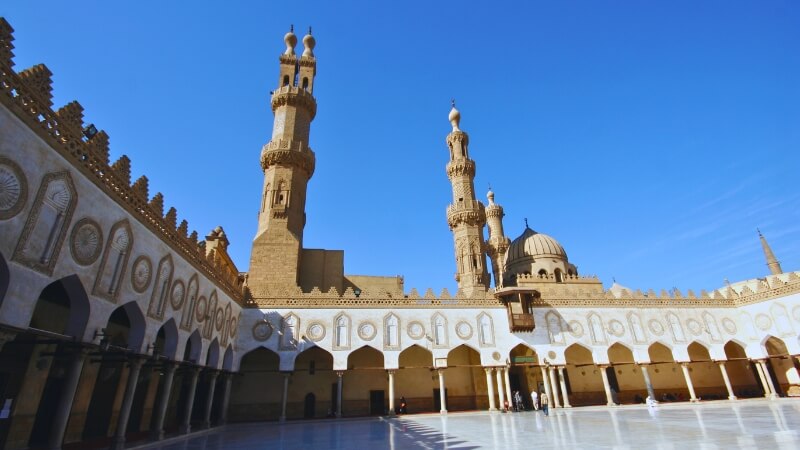Imagine walking through the historic district of Islamic Cairo. It’s filled with rich cultural heritage. Home to some of the most significant Islamic landmarks in the world.
This area is in the heart of Egypt’s capital. It’s a must-visit tourist destination. It offers a unique mix of history, architecture, and spirituality.
As you explore Cairo’s Islamic heritage, you’ll find a treasure trove of Cairo attractions. From ancient mosques to vibrant markets.
This guide will take you on a journey through Cairo Islamic culture. We’ll highlight the top experiences and insights. Make your visit truly unforgettable.
The Rich Heritage of Islamic Cairo
It is full of religious buildings and landmarks. These have greatly shaped Egypt’s culture. As you walk through, you’ll see many sites that are both beautiful and historically important.
The area is filled with mosques, madrasas, and mausoleums from different Islamic periods. Each one shows the architectural styles and religious practices of its time. These religious buildings are not just places of worship. They also show Egypt’s rich cultural heritage and its role in the Islamic world.
Exploring Islamic Cairo’s landmarks gives you a peek into the past. You’ll learn about the region’s complex history and its role in Egypt’s history. From Al-Azhar Mosque to Bab Zuweila gates, each site offers a unique look into the past.
As you explore it, you’ll see the mix of Islamic history and Egyptian culture. This makes Islamic Cairo a key place to visit for history, architecture, or cultural heritage lovers.
Don’t miss out on our Private Day Tour to Coptic and Islamic Cairo
10 Magnificent Landmarks of Islamic Cairo You Can’t Miss
It is full of landmarks like the Sultan Hassan Mosque and Cairo Citadel. These places are filled with history and amazing architecture. As you walk through, you’ll see many sites that show the area’s rich culture and buildings.
The Sultan Hassan Mosque is famous for its Mamluk design. It was built in the 14th century. This mosque shows the area’s history and building skills.

Top Landmarks in Islamic Cairo
- Cairo Citadel: Built by Saladin in the 12th century, it’s a key spot. It gives you amazing views of the city.
- Al-Azhar Mosque: It’s one of the oldest and most important Islamic schools. It’s a center of Islamic learning and culture.
- Ibn Tulun Mosque: This mosque is from the 9th century. It mixes Islamic and Roman styles.
- Al-Hakim Mosque: Built during the Fatimid era, it’s known for its unique design.
- Mosque of Muhammad Ali: Inside the Cairo Citadel, it shows Ottoman architecture. It also has great views of the city.
- Bayt Al-Suhaymi: This historic house shows Islamic architecture. It gives a peek into Cairo’s elite during the Ottoman era.
- Qalawun Complex: It includes a mosque, madrasa, and mausoleum. It’s a masterpiece of Mamluk architecture.
These Islamic landmarks show Islamic Cairo’s rich history and culture. They also highlight the area’s architectural innovation. Exploring these sites helps you understand Mamluk architecture and the landmarks’ historical value.
The Breathtaking Mosques That Define Islamic Cairo
Walking through Islamic Cairo, you’ll see amazing mosques everywhere. These buildings are more than places to pray. They show the area’s deep history and stunning architecture.
Interior Highlights and Panoramic Views
The mosques here are famous for their Islamic design. The Al-Azhar Mosque is a prime example. It has beautiful stone carvings, fancy tile work, and tall minarets.
Inside, you’ll see beautiful calligraphy and a peaceful courtyard. From the minarets, you get amazing views of the city.
Historical Significance and Ottoman Influence
These mosques are not just beautiful. They also hold a lot of history. Many were built during the Fatimid era, with others added later by the Ottomans.
The Ottoman style is clear in their design. You’ll see domes and minarets. Visiting these mosques helps you understand Islamic Cairo’s rich past.
The mosques in Cairo are truly amazing. They show the area’s rich culture and architecture. Exploring these places, you’ll see their beauty, history, and importance.
Walking Through the Historic Streets
As you wander through it, you’ll find a wealth of cultural heritage. This area is famous for its history, lively markets, and beautiful buildings.
The streets are filled with heritage sites, each with its own story. You’ll have many chances to capture Islamic Cairo’s beauty.
Notable Buildings and Photo Opportunities
Islamic Cairo boasts many famous buildings that show off Islamic art and architecture. You’ll see mosques and gates that tell the city’s story. Make sure to take photos of these amazing sights.
Some landmarks are perfect for photos, with their stunning looks and lively scenes.
Local Artisans and Workshops
While exploring, you’ll meet local artisans and workshops. They keep traditional crafts alive, like woodworking and textiles. These artists are keeping Islamic art alive.
Talk to the artisans, learn about their work, and take photos. This is a special way to see Islamic Cairo’s cultural heritage up close.
The Architectural Wonders of the Mamluk Era
Exploring Islamic Cairo, you’ll see the Mamluk era’s architectural wonders. This time was full of growth in culture and buildings. Mamluk Architecture is known for its grand style and detailed work. It shows the era’s Islamic history and culture.
The Sultan Hassan Mosque is a key example of Mamluk architecture. Built during Sultan Hassan’s rule, it’s famous for its size and detailed design. Its massive walls and tall minarets show the skill of Mamluk architects.
The Cairo Citadel is another marvel of the Mamluk era. It sits on a hill, overlooking the city. It was a power center for the Mamluk sultans. The Citadel’s mix of defense and luxury shows its important role in history.
But the Mamluk era’s achievements go beyond these buildings. Islamic Cairo is full of mosques, madrasas, and mausoleums. They all show the era’s creativity and cultural depth.
In summary, the Mamluk era’s buildings are a testament to Islamic Cairo’s rich culture and history. Walking through Islamic Cairo, you’ll see the beauty and grandeur of these structures. They give us a peek into a time of architectural greatness.
Islamic Art and Craftsmanship You’ll Discover in Cairo
Islamic Cairo is filled with stunning Islamic art. You’ll see intricate calligraphy, geometric patterns, and ornate decorations. This area shows the cultural and religious heritage of the region through art.
The mosques in Islamic Cairo are amazing. Mosques like Al-Azhar and Sultan Hassan have incredible architecture. They have detailed stone carvings, stunning stained glass, and beautiful minbars.
There are also museums and cultural landmarks in Islamic Cairo. They show the region’s rich cultural heritage. You’ll see beautiful Islamic art, like patterned textiles, ceramics, and metalwork. These pieces show the skill of the craftsmen and the traditions of the Islamic world.
Walking through Islamic Cairo’s streets, you’ll see and hear a vibrant culture. This area is full of Islamic art and culture. It has many attractions that show the region’s history and importance. Whether you love history, architecture, or art, Islamic Cairo has something for you.

The Fatimid Legacy
Exploring Islamic Cairo means seeing the Fatimid dynasty’s mark. Their rule, starting in the 10th century, left many historic sites. These sites still draw in visitors today.
Bab Zuweila and the Ancient City Gates
Bab Zuweila is a key Fatimid landmark. It’s one of Cairo’s old gates. This historic landmark has seen a lot, from defending the city to symbolizing the Fatimid era.
Walking through it, you feel like you’ve stepped back in time. You see the grandeur of Islamic Cairo’s past.
Al-Aqmar Mosque: The Moonlit Mosque
The Al-Aqmar Mosque is another Fatimid gem. It’s famous for its beautiful facade and detailed stone carvings. Built in 1125, it’s a prime example of Fatimid architecture.
Its name, “Al-Aqmar,” means “the moonlit” in Arabic. The mosque’s design is peaceful and sacred, showing the Fatimid style.
The Fatimid dynasty’s mark on Islamic Cairo is clear. Landmarks like Bab Zuweila and Al-Aqmar Mosque show their architectural and cultural influence. Exploring these sites helps you understand Islamic Cairo’s rich heritage.
Practical Tips for Exploring Cairo Islamic Like a Local
To truly experience Islamic Cairo, you’ll need to navigate its historic streets effectively. The area is rich in history and culture, with numerous landmarks to explore.
Transportation Options and Walking Routes
Islamic Cairo is relatively compact, making it accessible on foot. You may also use taxis or ride-sharing services for convenience. Walking is the best way to discover hidden gems and experience the local atmosphere. When walking, be sure to wear comfortable shoes and stay hydrated.
The main streets, such as Al-Azhar Street and Salah Salem, are well-traveled and offer a glimpse into local life. For a more immersive experience, explore the narrower alleys and side streets. There, you can find unique shops and eateries.
Guided Tours vs. Independent Exploration
Whether to take a guided tour or explore independently depends on your personal preference. Guided tours can provide valuable insights and historical context, helping you understand the significance of the landmarks. On the other hand, independent exploration allows you to set your own pace and discover unexpected treasures.
If you choose to go solo, consider purchasing a map or using a GPS device to navigate the area. Many locals are also happy to offer directions or recommendations when asked.
In conclusion, exploring Islamic Cairo can be a rewarding experience with the right approach. By understanding your transportation options and choosing the best way to explore the area, you can make the most of your visit.
5 Hidden Gems Off the Beaten Path in Islamic Cairo
Islamic Cairo has many hidden treasures for those who explore. While many visit famous mosques, there are many hidden gems to find. These spots are not as well-known but are just as fascinating.
Where to Find the Best Egyptian Coffee
Don’t miss trying traditional Egyptian coffee at cozy cafes. Look for local coffee shops in the narrow streets. Here, you can enjoy a rich, cardamom-flavored coffee in a warm setting.
These cafes are often family-run and have been around for years. They give a peek into local life. As you drink your coffee, notice the Islamic landmarks around you.
Traditional Foods to Try in the Islamic Quarter
Islamic Cairo is great for food lovers. Try local dishes like koshari or ta’ameya, Egyptian falafel. For dessert, check out local bakeries with many pastries.
While walking around Cairo mosque areas, you’ll find street food and eateries. Be brave and try new foods to enjoy Egyptian flavors.
Islamic Cairo also has many Islamic landmarks to see. Walking the historic streets, you’ll find unique buildings and learn about their history.
Exploring these local spots helps you understand Islamic Cairo’s culture better. It’s a way to see beyond the usual tourist places.
Conclusion: The Timeless Appeal of Islamic Cairo
Exploring Islamic Cairo is like stepping into a world of rich history. You’ll see historic landmarks, beautiful mosques, and a lively culture. It’s a place that never loses its charm.
Walking through Islamic Cairo, you’ll see amazing buildings from the Mamluk and Fatimid eras. The Islamic art and craftsmanship here are truly special. It’s a place you must see.
Islamic Cairo is full of hidden treasures and helpful tips for visitors. It’s an experience you won’t forget. Reflecting on its history and culture, you’ll see why it’s a favorite spot for travelers. It truly captures the essence of Egypt’s past.




